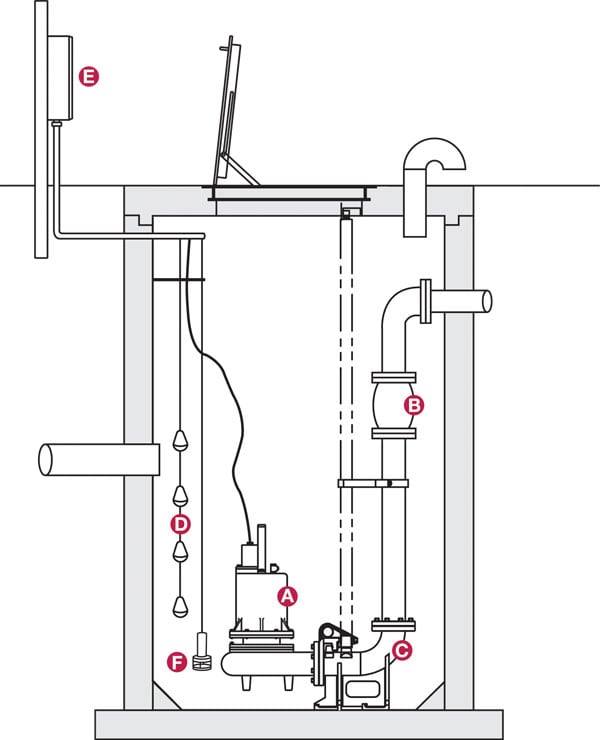
Wastewater lift stations play a crucial role in modern urban planning and wastewater management. In this comprehensive guide, we will explore the definition, function, importance, components, types, design, installation, maintenance, and troubleshooting of these essential systems.
Understanding Wastewater Lift Stations
Definition and Function of Wastewater Lift Stations
A wastewater lift station, also known as a pump station or sewage lift station, is a critical infrastructure component that helps transport wastewater from lower to higher elevations. They are typically used in areas where the natural slope of the terrain does not allow for gravity-driven flow towards the treatment plant or higher point of discharge.
Wastewater lift stations consist of various mechanical and electrical components that work together to facilitate the movement of wastewater. Their main function is to lift the wastewater from a lower elevation to a higher elevation, overcoming the differences in elevation and enabling the continuous flow towards the treatment facility.
These lift stations are equipped with powerful pumps that are capable of handling large volumes of wastewater. The pumps are designed to efficiently move the wastewater through the system, ensuring that it reaches its destination without any interruptions or delays. Additionally, lift stations are equipped with sensors and control systems that monitor the flow and pressure of the wastewater, ensuring optimal performance and preventing any potential issues.
Furthermore, lift stations are equipped with emergency backup systems, such as generators, to ensure continuous operation even during power outages. This is crucial to prevent any disruptions in the wastewater transport process and to avoid potential health and environmental hazards.
Importance of Wastewater Lift Stations in Urban Planning
In urban planning, wastewater lift stations are integral for ensuring efficient and effective sewage system operation. Without these lift stations, it would be challenging to transport wastewater from areas of low elevation to the treatment plant or discharge points located at higher elevations.
Proper urban planning takes into account the topography and hydraulic requirements of an area to determine the optimal location and design of wastewater lift stations. By strategically placing lift stations throughout a city or town, planners can ensure the reliable and continuous transport of wastewater, minimizing the risk of overflows, backups, and environmental contamination.
Moreover, wastewater lift stations play a crucial role in preventing the contamination of water sources. By efficiently transporting wastewater to treatment facilities, lift stations help remove harmful pollutants and pathogens from the water, ensuring that it can be safely discharged back into the environment or reused for various purposes.
Additionally, the presence of well-maintained and properly functioning lift stations contributes to the overall cleanliness and hygiene of urban areas. By effectively managing the wastewater flow, lift stations help prevent foul odors, unsightly sewage backups, and the spread of diseases, creating a healthier and more pleasant living environment for residents.
Furthermore, wastewater lift stations are designed to handle not only residential wastewater but also commercial and industrial wastewater. This is particularly important in urban areas with a mix of residential, commercial, and industrial zones. Lift stations are equipped to handle the diverse types and volumes of wastewater generated by different sources, ensuring that the sewage system can effectively manage the entire spectrum of wastewater in the area.
In conclusion, wastewater lift stations are essential components of urban infrastructure that play a vital role in the efficient and effective transport of wastewater. By overcoming elevation differences and facilitating continuous flow, these lift stations contribute to the cleanliness, hygiene, and environmental sustainability of urban areas.
Components of a Wastewater Lift Station
Wet Well: The Heart of the System
The wet well is the primary storage and collection chamber in a wastewater lift station. It serves as a receptacle for the incoming wastewater before it is pumped to a higher elevation. The wet well is designed to accommodate variable flow rates and prevent overflow by providing a storage buffer.
Wet wells are usually constructed from corrosion-resistant materials such as concrete or fiberglass to withstand the harsh chemical environment of the wastewater. They incorporate features such as access hatches, venting systems, and liquid level sensors for efficient operation and maintenance.
Within the wet well, the wastewater undergoes a series of physical and chemical processes. The solids settle at the bottom, forming a layer of sludge, while the lighter materials, such as grease and oil, float to the surface, creating a layer of scum. These layers are periodically removed to maintain the efficiency of the lift station.
The wet well also plays a crucial role in odor control. To minimize unpleasant odors, the wet well is equipped with ventilation systems that capture and treat the foul air, preventing it from escaping into the surrounding environment.
Pumps and Valves: The Workhorses
Pumps and valves are essential components of any wastewater lift station. Pumps are responsible for lifting and transporting the wastewater from the wet well to the desired discharge point. They come in various types and sizes, including centrifugal pumps, submersible pumps, and positive displacement pumps, depending on the specific application and operational requirements.
The selection of the appropriate pump is crucial to ensure efficient and reliable operation. Factors such as flow rate, head pressure, and the characteristics of the wastewater must be considered. Additionally, pumps are equipped with various features, such as impellers and seals, to handle different types of solids and prevent clogging.
Valves, on the other hand, control the flow and pressure within the system. They regulate the pump operation, prevent backflow, and enable maintenance and repair tasks by isolating different sections of the lift station. Commonly used valves include gate valves, check valves, and control valves.
Valves are strategically placed throughout the lift station to optimize the flow of wastewater. They are designed to withstand the corrosive nature of the wastewater and are often made from materials such as stainless steel or PVC.
Control Panel: The Brain of the Operation
The control panel is the central command unit of a wastewater lift station. It houses the electrical components, including motor starters, relays, sensors, and programmable logic controllers (PLCs), that monitor and control the lift station's operation.
The control panel receives signals from various sensors throughout the lift station, such as liquid level sensors, pressure sensors, and temperature sensors. It uses these inputs to automatically adjust pump operation, monitor system performance, generate alarms for abnormal conditions, and provide remote monitoring capabilities.
PLCs are the heart of the control panel, responsible for executing complex control algorithms and ensuring the proper sequencing of pumps and valves. They provide real-time data logging, trending, and analysis, allowing operators to optimize the lift station's performance and identify potential issues before they escalate.
The control panel is also equipped with human-machine interface (HMI) devices, such as touchscreens or control panels, that allow operators to monitor and control the lift station's operation. Through the HMI, operators can view system status, adjust setpoints, and access historical data for analysis and reporting.
Furthermore, the control panel incorporates various safety features, such as emergency stop buttons and fault detection systems, to protect personnel and equipment from potential hazards. It also provides backup power supply options, such as uninterruptible power supply (UPS) systems or backup generators, to ensure continuous operation during power outages.
Types of Wastewater Lift Stations
Submersible Pump Stations
Submersible pump stations are designed with the pumps located directly inside the wet well. Immersed in the wastewater, these pumps are specifically designed to handle the challenging conditions of submerged operation. Submersible pump stations are a popular choice due to their compact design, ease of installation, and low maintenance requirements.
Dry-Pit Pump Stations
Dry-pit pump stations, as the name suggests, have the pumps placed outside the wet well in a separate dry chamber. These stations require dry-well or valve vault construction, which provides easy access to the pumps and associated electrical components. Dry-pit pump stations are often preferred in areas with high groundwater levels or corrosive soils.
Wet-Pit Pump Stations
Wet-pit pump stations are similar to dry-pit pump stations, but they have the pumps situated directly in the wet well. These stations are commonly used for large-scale applications where high flow rates or significant changes in elevation need to be accommodated. Wet-pit pump stations offer efficient and reliable operation, especially in situations where space constraints or cost considerations limit the use of submersible pumps.
Designing and Installing a Wastewater Lift Station
Key Considerations in Design
Designing a wastewater lift station involves careful consideration of several factors, including hydraulic calculations, lift station capacity, pump selection, electrical requirements, wet well design, odor control, and safety considerations. Proper planning and design ensure the lift station meets the specific requirements of the site and minimizes the potential for operational issues.
It is essential to work closely with experienced engineers and consultants who specialize in lift station design to ensure compliance with regulatory standards, optimize performance, and minimize lifecycle costs.
Installation Process and Best Practices
The installation process of a wastewater lift station involves site preparation, excavation, wet well construction, pump and valve installation, electrical connections, control panel setup, and testing. Each step requires adherence to established guidelines, specifications, and safety protocols.
Proper installation and adherence to best practices not only ensure the lift station operates reliably but also facilitate future maintenance and troubleshooting efforts. It is crucial to follow manufacturer recommendations, industry standards, and local regulations throughout the installation process.
Maintenance and Troubleshooting of Wastewater Lift Stations
Routine Maintenance Tasks
Maintaining a wastewater lift station involves routine tasks to ensure optimal performance and prevent potential issues. These tasks include regular inspections of pumps, valves, control panels, and wet well components, lubrication of moving parts, cleaning of debris and sediments, testing of alarms and sensors, and calibration of instrumentation.
Implementing a proactive maintenance plan can help identify and address minor issues before they escalate into costly repairs or system failures. Following the manufacturer's recommended maintenance schedules and guidelines is crucial to keep the lift station in proper working condition.
Common Problems and Solutions
Despite proper maintenance, wastewater lift stations may encounter various problems during their operational lifespan. Common issues include pump failures, clogging, electrical malfunctions, control system errors, excessive noise, and odor nuisance.
Troubleshooting these problems requires a systematic approach that involves isolating the issue, identifying the root cause, and implementing appropriate solutions. Qualified technicians with expertise in lift station operation and maintenance are instrumental in diagnosing and rectifying these problems.
Conclusion
Wastewater lift stations are vital components of modern urban planning and wastewater management. Understanding their definition, function, components, types, design considerations, installation process, maintenance tasks, and troubleshooting principles is crucial for ensuring the efficient and reliable operation of these systems.
Proper lift station design, installation, and maintenance practices, in conjunction with skilled professionals, help mitigate potential issues and optimize the performance of wastewater lift stations, leading to improved wastewater conveyance, reduced environmental impact, and enhanced public health and safety.

